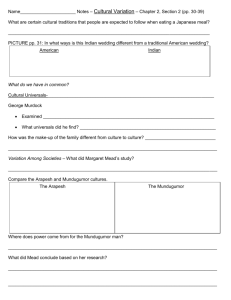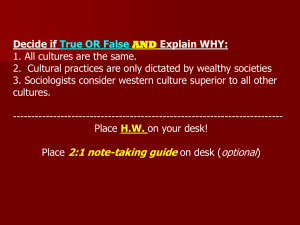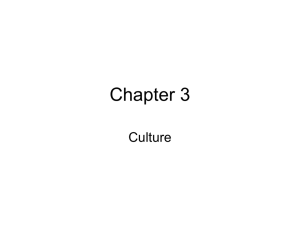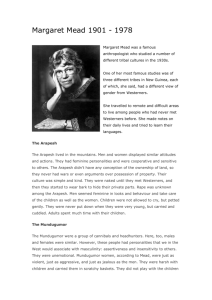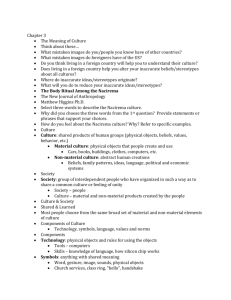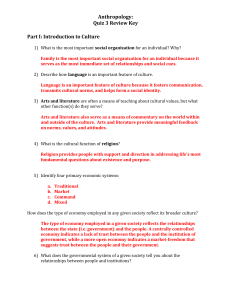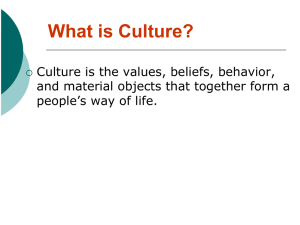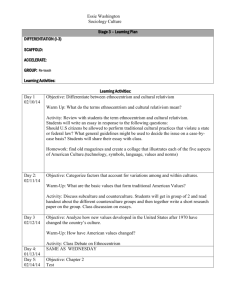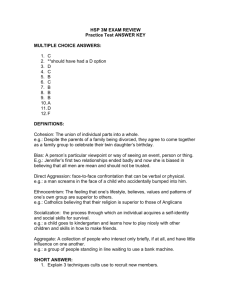Chapter 2 - Mr. Dan`s Classes
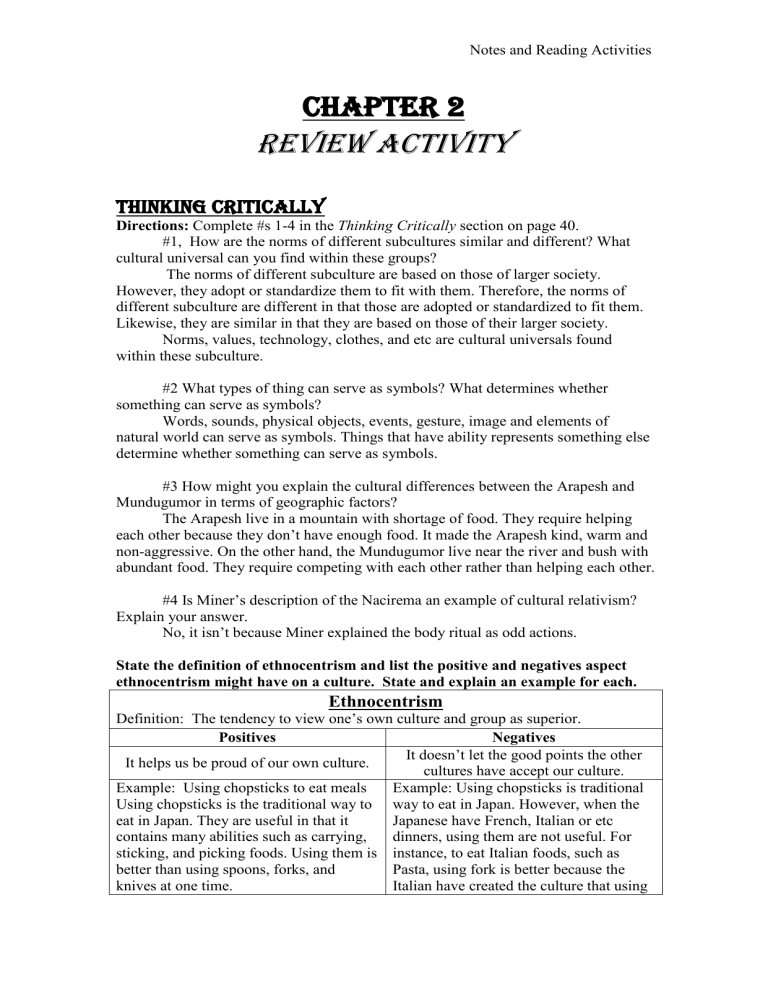
Notes and Reading Activities
Chapter 2
Review Activity
Thinking Critically
Directions: Complete #s 1-4 in the Thinking Critically section on page 40.
#1, How are the norms of different subcultures similar and different? What cultural universal can you find within these groups?
The norms of different subculture are based on those of larger society.
However, they adopt or standardize them to fit with them. Therefore, the norms of different subculture are different in that those are adopted or standardized to fit them.
Likewise, they are similar in that they are based on those of their larger society.
Norms, values, technology, clothes, and etc are cultural universals found within these subculture.
#2 What types of thing can serve as symbols? What determines whether something can serve as symbols?
Words, sounds, physical objects, events, gesture, image and elements of natural world can serve as symbols. Things that have ability represents something else determine whether something can serve as symbols.
#3 How might you explain the cultural differences between the Arapesh and
Mundugumor in terms of geographic factors?
The Arapesh live in a mountain with shortage of food. They require helping each other because they don’t have enough food. It made the Arapesh kind, warm and non-aggressive. On the other hand, the Mundugumor live near the river and bush with abundant food. They require competing with each other rather than helping each other.
#4 Is Miner’s description of the Nacirema an example of cultural relativism?
Explain your answer.
No, it isn’t because Miner explained the body ritual as odd actions.
State the definition of ethnocentrism and list the positive and negatives aspect ethnocentrism might have on a culture. State and explain an example for each.
Ethnocentrism
Definition: The tendency to view one’s own culture and group as superior.
Positives
It helps us be proud of our own culture.
Example: Using chopsticks to eat meals
Using chopsticks is the traditional way to eat in Japan. They are useful in that it contains many abilities such as carrying, sticking, and picking foods. Using them is better than using spoons, forks, and knives at one time.
Negatives
It doesn’t let the good points the other cultures have accept our culture.
Example: Using chopsticks is traditional way to eat in Japan. However, when the
Japanese have French, Italian or etc dinners, using them are not useful. For instance, to eat Italian foods, such as
Pasta, using fork is better because the
Italian have created the culture that using
Notes and Reading Activities such utensils to eat its culture’s food.
Understanding Main ideas
Directions: Complete item #s 1-7 in Understanding Main Ideas on page 40.
1.
List five examples of material culture and five examples of nonmaterial culture
Examples of material culture are pencils, notes, pen case, high-lighter, and pieces of paper. Examples of non-material culture are rules, knowhow, beliefs, practices, and norms.
2. What is language and why is it such an important part of culture?
Language is a skill of communication. It is important because every person in culture have to communicate each other. If there is no language, people can’t express their thinking.
3. How do folkways, mores and laws differ? List three examples of each type of norm.
Folkways are acceptable behavior but it isn’t significant to people. Examples of folkways are covering mouth when coughing, pointing people by index finger, and not washing the body for a long time.
Mores are acceptable behavior but it is significant to people. Examples of mores are cheating on a test, violence to people, violate the rule of schools.
Laws are written rules that is enforced and enacted by the government. Examples of laws are not killing people, stealing, using drugs.
4. how do cultural traits, cultural complexes, and cultural patterns differ?
Cultural traits are the smallest elements that cultures contain.
Cultural complexes are consisted of cultural traits and make larger things.
Cultural patterns are the biggest elements that cultural complexes organize.
5. How did Margaret Mead contribute to the study of cultures?
Margaret Mead found that the geographical factors can affect the cultural characteristics such as temperament.
6. What is ethnocentrism? How does it differ from cultural relativism?
It is the tendency to view one’s own culture and group as superior. It differs from cultural relativism in that judging a culture by a view of own standard rather than its view.
7. How are subcultures and countercultures related?
Sub-cultures and countercultures are related to their original culture. They are made by being based on the larger society.
Notes and Reading Activities
Interview Activity
Directions: First, answer the content question below using your notes and textbook.
Then, answer the parental question by asking one of your parents or an adult with children from your culture to help you answer this question.
Content Question: How did the Arapesh and Mundugumor’s parenting practices help teach their cultures’ norms and values to their children?
Arapesh’s parent practices are gentler than which of Mundugumor. It helps the adult teach their children to behave like the parants.
On the other hand, Mudugumor’s parenting practices are harsher than which of
Arapesh. Therefore, the children will behave like what they have been behaved.
Parental Question: What are some norms and values native to your culture? How do parents in your society teach these values to their children?
In Japan, children are usually shy so they sometimes don’t greet to acquaintances.
When children do so, parents teach their children aggressively but it is not as harsh as
Mundugumor do.
Writing About Sociology
Answer #1 from the Writing about Sociology section on page 40.
If I invite a friend form foreign country, they might feel odd and unfamiliar with a lot of things. First, the friend must dress Japanese traditional costume called
Kimono. They must be unfamiliar with wearing Kimono. But, in case of a child, usually they can avoid to wear Kimono because they are too young to behave like an adult. During eating, the place where a dinner is held is quiet. Talking loudly might be not acceptable. Also, the friend might not be able to drink foreign alcohols such as beer and whisky. They drink alcohol called Nihonshu. It means Japanese alcohol.
For entertainment, some ladies dressing Kimono will dance by using a holding fan, and a small drum. They watch dancing ladies even some Japanese like me don’t enjoy it. Therefore, it must be boring for foreigners.

